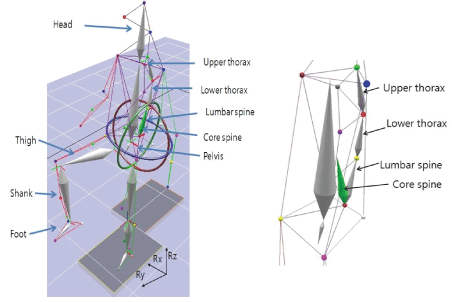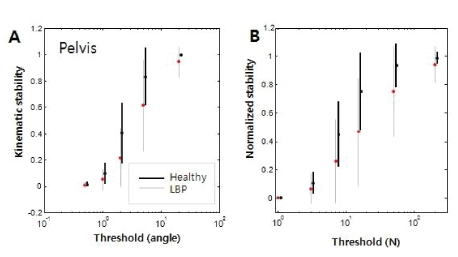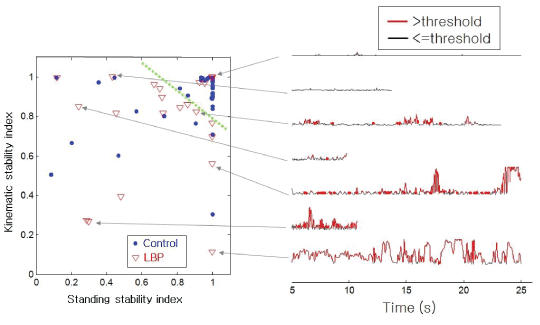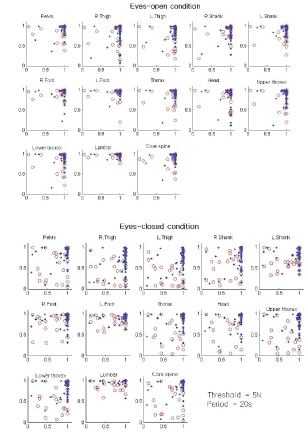Commentary Open Access
Kinetic and Kinematic Analyses of One Leg Standing on Core Spinal Stability in Subjects with Recurrent Low Back Pain
| Paul S. Sung* | |
| Department of Physical Therapy, the University of Scranton, USA | |
| Corresponding Author : | Sung PS Department of Physical Therapy, Panuska College of Professional Studies The University of Scranton, 800 Linden St, Scranton, PA 18510, USA Tel: 570-941-6070 Fax: 570-941- 7940 E-mail: drpsung@gmail.com |
| Received: July 12, 2015 Accepted: October 12, 2015 Published: October 14, 2015 | |
| Citation: Sung PS (2015) Kinetic and Kinematic Analyses of One Leg Standing on Core Spinal Stability in Subjects with Recurrent Low Back Pain. J Pain Relief 4:212. doi:10.4172/21670846.1000212 | |
| Copyright: © 2015 Sung PS. This is an open-access article distributed under the terms of the Creative Commons Attribution License, which permits unrestricted use, distribution, and reproduction in any medium, provided the original author and source are credited. | |
| Related article at Pubmed, Scholar Google | |
Visit for more related articles at Journal of Pain & Relief
Abstract
Recurrent low back pain (LBP) is the most commonly encountered medical condition in older adults and poses an even greater challenge in health care. This commentary proposes biomechanical outcome assessments of spinal function and implies an objective measurement to assess recurrent LBP. It is important to determine the potential characteristics of kinematic (range of motion, velocity, and acceleration) and kinetic (resulting from motion) indices while considering spinal proprioception during the one leg standing test. This comprehensive approach provides kinetic and kinematic analyses on core spine stability and postural reaction in order to integrate motor control and biomechanics in whole human motion for rehabilitation strategies. This outcome measurement may implement a paradigm shift to evidence-based, quantitative approaches to enhance quality of care for subjects with recurrent LBP for injury prevention. Furthermore, the interventions relate to changes in motor control, which plays a key clinical role and should be considered in terms of the musculoskeletal and neurological links for subjects with recurrent LBP.
| Keywords |
| Low back pain; Kinematic; Kinetic; Stability; One leg standing |
| Introduction |
| Low back pain (LBP) affects work performance and social responsibilities and is increasingly a major factor in escalating healthcare costs [1]. A global review of LBP has shown its point prevalence to be approximately 12%, with a one-month prevalence of 23%, a one-year prevalence of 38%, and a lifetime prevalence of approximately 40% [2]. One study reported that between 24% and 80% of subjects with LBP experienced recurrent episodes within one year [2]. |
| Individuals with a recurrence of LBP are generally referred to as those who first recovered from the original episode and then experience a new episode of LBP. Those subjects with recurrent LBP often demonstrate a less refined positional sense with altered proprioceptive postural control, as well as exhibit poor strength of the abdominal and paraspinal muscles for core stability [3-5]. Core stability includes the trunk muscles for an optimal production of force to coordinate lumbopelvic-hip movement as well as appropriate load transfer from the spine to distal segments [6-8]. However, there is a lack of objective measurement on altered kinematic patterns of the spine in subjects with recurrent LBP. |
| Evidence-based intervention has stressed to researchers and clinicians the importance of establishing a strong link between treatments and outcomes. Various studies have suggested that exercise programs are effective [9-12]. However, most researchers failed to provide evidence favoring one exercise over another for treatment of recurrent LBP. The contradicting results might be related to poor sensitivity of the instruments, an unmatched design of research, small sample sizes, and/or a lack of a valid and reliable index. Most clinical outcome studies are still not convincing, and the morphological and functional implications in the neuro-musculo-skeletal system need to be further investigated. |
| It is necessary to provide sensitive kinetic and kinematic indices for quantitative evaluation of altered postural coordination in subjects with recurrent LBP. Kinetic and kinematic data regarding spinal dysfunctions and a lack of coordination may provide clinical insight of motor control and integration patterns of trunk compensatory movements in subjects with recurrent LBP [13,14]. Several studies reported variations in balance and body sway compensations by postural alignment and core spine stability on kinematic changes of the dominant thigh and pelvis [13,15]. Another study reported that active limb movements may be associated with early lumbopelvic motion; and the increased frequency may contribute to increased lumbar region tissue stress and potentially LBP symptoms [16] since altered movements are known to decrease with muscular force-generating capabilities [17,18]. |
| Clinicians often assess movement performance to observe biomechanical deficits with the one leg standing test, which is sensitive to be utilized for core spine stability as approximately 40% of human gait movement occurs during one leg stance [19,20]. The one-leg standing test examines the ability of spinal load transfers to optimize stability of the pelvic girdle unilaterally as well as for detecting relative innominate bone motion [21]. A kinematic analysis of the body region and the kinetic analysis from the force plate could be useful to understand core spine activity with the whole body during the one leg standing test. This integrated spinal stability might enhance motor control strategies in subjects with recurrent LBP. |
| Outcome measurement based on kinetic and kinematic stabilities |
| The maintenance of balance is influenced by a range of several sensorimotor functions, including muscular strength, proprioception, and the visual and vestibular sensory systems [22-24]. Kinematic stability has frequently been used for balance assessments based on the ground reaction force and muscle activities [25-27]. The performance of postural stability reflects kinematic changes during standing, [28] which might be due to proprioceptive deficits in the spinal region [29-31]. However, most studies did not investigate both kinematic and kinetic indices for analysis of spinal region while considering visual input. |
| Clinicians need to apply the one leg test to assess postural compensation strategies as well as position-dependent spinal loading for rehabilitation strategies with and without visual input. During the test, subjects stand on a single leg with the contra lateral hip flexed 90 degrees for approximately 20 seconds (Figure 1). The postural compensation strategies used by the subjects and based on the kinetic and kinematic data as well as visual input may lead to a better understanding of spinal movement patterns to clarify the comprehensive changes. |
| There is growing scientific evidence supporting a musculoskeletal and neurological link. For example, older adults possess altered sensory [32] and musculoskeletal systems, [33,34] leading to altered control of movement and posture. Several other studies also reported spinal dysfunction with individual characteristics [35-37]. However, these results were not consistent due to the lack of matched samples, invalid measures in a controlled study design, and/or poor reliability of assessment tools. |
| The stability index was developed with two parameters—relative standing time and relative standstill time [14]. The relative standing time was defined as the ratio between the successful standing time and the requested standing time. The successful standing time was measured as the total standing time until the subject failed to maintain stability during 20 seconds. The relative standstill time was defined as the ratio between the sum of standstill time and successful standing time, which was used to compare individuals. The standstill time was the summation of the temporal segments where the three-dimensional rotation of the tested axis goes below threshold (5 degrees). |
| The normalized kinematic and kinetic changes for postural stability were compared for the balance test. In Figure 2, the threshold sensitivity of kinetic and kinematic stability indices was plotted between groups. The kinematic and kinetic data were normalized because the various individual differences might be fairly compared between groups. The normalized kinematic stability index for specific portions of the body was compared with the stability index from the force plate. Therefore, the method of our research included the evaluation of kinematic changes and any relationship between these two indices during the balance test. |
| As shown in Figure 2, the angular displacement of the lumbar spine was calculated from the average, and then temporal summation of the data was used to calculate the normalized kinematic index for each spinal region. The rotational displacement (Rxyz) of the tested axis was below the threshold Th_k (5 degrees), and the summation of Rxyz was computed as a square sum of the three directional rotation angles of which the average value was subtracted to obtain each plane average. Therefore, the normalized Rxyz was calculated based on the 5 degrees of the threshold value [13]. |
| The one leg standing test has been utilized to quantitatively assess postural steadiness in a static position in order to investigate various balance disorders. In Figure 3, the data obtained from seven subjects were selected as examples of the standing stability index, which was the ratio between standing duration and requested duration. The normalized standing index was compared with the corresponding subjects’ Rxyz values. The average position of the feet varied somewhat from trial to trial after 25 to 30 seconds because the subject stepped off of the force plate. In addition, several authors [38,39] utilized 20 seconds of data from 30 or 40 second trials for the balance test. Another study also investigated the first 5 seconds of the entire 25 second test, which was defined as a dynamic phase [40]. Other data indicated high variability during this period, which could be caused by muscular or postural adjusting components [41,42]. Therefore, the data obtained after the initial 5 seconds of the static phase for the purpose of the study. |
| Kinematic stability depends on good motor control as well as sensory feedback, which comes from vision, proprioception, and vestibular sensation [14,43]. The combined stability was significantly greater with visual input, and the stability of the lumbar spine remained very high for all conditions. However, the core spine stability of the subjects with recurrent LBP significantly decreased during the test, especially when visual input was blocked. The combined stability assessed the dynamic and temporal processes of balance; therefore, the kinematic result of the core spine is critical during the test since its stability is the core axis of trunk movement. |
| The core spine was used as a reference model for motion analysis to compare specific three-dimensional kinematic data and to differentiate with motion of the lumbar spine, which is directly articulated between the pelvis and the thorax [43]. A lack of kinematic and kinetic coordination of the lumbar spine may cause musculoskeletal injuries, especially with sudden perturbation [27,44]. In addition, the altered coordination within the postural reaction might lead to compensatory responses to prevent injuries. |
| The kinematic aspect of trunk mobility plays a critical role with spinal stability in posture and balance, which is related to the fact that the axial musculature is involved in both static and dynamic postural control. In Figure 4 the subjects with recurrent LBP demonstrated instability of the kinematic and kinetic stability, especially when visual feedback was blocked. The kinetic stability also revealed that the control group demonstrated significantly better stability during single leg standing. Regarding the relationship between normalized kinematic stability and kinetic stability from the force plate, the control group demonstrated better stability than the subjects with LBP. It would be important to analyze any interaction between normalized kinematic and kinetic stabilities for postural control which might provide additional compensatory reactions. An altered postural control could affect compensatory strategies and lead to pathologic movement patterns [13,14]. This compensatory movement pattern of the spine within postural reaction might provide possible injury prevention. |
| Diminished feedback for core spine control might be compensated by either the pelvis or the lumbar spine for integrated balance performance in subjects with recurrent LBP. This adaptation might prove enlightening for core spine integrity as well as clinically relevant differences of the whole body reaction in subjects with recurrent LBP. Clinicians need to consider motor control of integrated kinetic and kinematic changes to refine balance strategies in subjects with recurrent LBP. Further studies are warranted for kinetic and kinematic analyses to assess spinal dysfunctions and postural stability during various tasks. |
| Clinical Implications |
| The one leg standing test could be utilized to quantitatively assess postural steadiness in a static position to investigate various balance disorders in subjects with recurrent LBP. In a previous study, the normalized standing index was compared with the corresponding subjects’ three- dimensional rotational values [43]. The stability index of the core spine significantly decreased, especially when visual feedback was blocked for subjects with recurrent LBP. The interaction between visual feedback and trunk rotation indicated that core spine stability is critical in coordinating balance control. |
| The control of spinal function might include excitability in the motor pathway with fearful aspects of pain. The combined kinematic analysis based on spinal regions and kinetic index from a force plate may provide comprehensive postural integrity strategies to reduce the risk of injury. A trunk muscle imbalance may contribute to unbalanced postural activity, which could prompt a decreased, uncoordinated bracing effect in subjects with LBP. As a result, core spine training could be used in the prevention of postural instability since comprehensive and objective outcomes with integrated motor function for impaired balance performance in subjects with LBP are needed. |
| It is evident that non-surgical spine research, as well as other fields of clinical research, should enhance the quality of clinical intervention with a developed theory of interventions. Sensitive measures are needed following the implementation of the intervention while still considering the potential factors based on individual variations as well as pain/level of disability following the specific interventions. The comprehensive effect of the intervention has to be investigated further with quantified measurement tools. For example, the center of pressure (COP) displacement may provide useful information as an index of standing postural stability as well as predict dynamic balance. However, the COP provides limited results with only two-dimensional quantities. The combined three-dimensional kinetic analyses from ground reaction forces with specific sensitive thresholds as well as kinematic index analysis provide more accurate and meaningful data for the outcome measure [14]. |
| It is important to investigate the effects of intervention in terms of the musculoskeletal or the neurological link within the interactions of the cardiovascular and integumentary systems of human motion. Although some therapeutic interventions have demonstrated benefits, researchers have not quantified or characterized the results yielded by specific non-surgical interventions. |
| Conclusion |
| The quantification of balance deficits based on kinematic and kinetic indices is valuable to a number of populations, including subjects with recurrent LBP. The comparison of postural control based on the normalized kinematic and kinetic stabilities during the one leg standing test might contribute to a further understanding of postural adaptations. As the normalized kinematic index for spinal stability significantly decreased during the eyes-closed condition, these indices could be utilized to compare postural integration as well as proprioceptive responses. This compensatory pattern needs to be further investigated for optimal injury prevention and rehabilitation programs. |
| Acknowledgements |
| This work was supported by Panuska College of Professional Studies at the University of Scranton, Pennsylvania. |
References
- Manchikanti L, Singh V, Falco FJ, Benyamin RM, Hirsch JA (2014) Epidemiology of low back pain in adults. Neuromodulation 17 Suppl 2: 3-10.
- Hoy D, Brooks P, Blyth F, Buchbinder R (2010) The Epidemiology of low back pain. Best Pract Res ClinRheumatol 24: 769-781.
- Heidari P, Farahbakhsh F, Rostami M, Noormohammadpour P, Kordi R (2015) The role of ultrasound in diagnosis of the causes of low back pain: a review of the literature. Asian J Sports Med 6: e23803.
- Hides J, Wilson S, Stanton W, McMahon S, Keto H, et al. (2006) An MRI investigation into the function of the transversusabdominis muscle during "drawing-in" of the abdominal wall. Spine (Phila Pa 1976) 31: E175-178.
- Teyhen DS, Miltenberger CE, Deiters HM, Del Toro YM, Pulliam JN, et al. (2005) The use of ultrasound imaging of the abdominal drawing-in maneuver in subjects with low back pain. J Orthop Sports PhysTher 35: 346-355.
- Kibler WB, Press J, Sciascia A (2006) The role of core stability in athletic function. Sports Med 36: 189-198.
- Lee T, Kim YH, Sung PS (2011) A comparison of pain level and entropy changes following core stability exercise intervention. Med SciMonit 17: CR362-368.
- Mok NW, Yeung EW, Cho JC, Hui SC, Liu KC (2015) Core muscle activity during suspension exercises. J Sci Med Sport 18: 189-194.
- Abenhaim L, Rossignol M, Valat JP, Nordin M, Avouac B (2000) The role of activity in the therapeutic management of back pain. Report of the International Paris Task Force on Back Pain. Spine (Phila Pa 1976) 25: 1S-33S.
- Byström MG, Rasmussen-Barr E, Grooten WJ (2013) Motor control exercises reduces pain and disability in chronic and recurrent low back pain: a meta-analysis. Spine (Phila Pa 1976) 38: E350-358.
- Kendall KD, Emery CA, Wiley JP, Ferber R (2015) The effect of the addition of hip strengthening exercises to a lumbopelvic exercise programme for the treatment of non-specific low back pain: A randomized controlled trial. J Sci Med Sport 18: 626-631.
- Searle A, Spink M, Ho A, Chuter V (2015) Exercise interventions for the treatment of chronic low back pain: A systematic review and meta-analysis of randomised controlled trials. ClinRehabil.
- Lee DC, Ham YW, Sung PS (2012) Effect of visual input on normalized standing stability in subjects with recurrent low back pain. Gait Posture 36: 580-585.
- Sung PS, Yoon B, Lee DC (2010) Lumbar spine stability for subjects with and without low back pain during one-leg standing test. Spine (Phila Pa 1976) 35: E753-760.
- Tsao H, Hodges PW (2008) Persistence of improvements in postural strategies following motor control training in people with recurrent low back pain. J ElectromyogrKinesiol 18: 559-567.
- Scholtes SA, Gombatto SP, Van Dillen LR (2009) Differences in lumbopelvic motion between people with and people without low back pain during two lower limb movement tests. ClinBiomech (Bristol, Avon) 24: 7-12.
- Hicks AL, Kent-Braun J, Ditor DS (2001) Sex differences in human skeletal muscle fatigue. Exerc Sport Sci Rev 29: 109-112.
- Hicks GE, Shardell M, Alley DE, Miller RR, Bandinelli S (2012) Absolute strength and loss of strength as predictors of mobility decline in older adults: the InCHIANTI study. J Gerontol A BiolSci Med Sci 67: 66-73.
- Aberg AC, Thorstensson A, Tarassova O, Halvorsen K (2011) Calculations of mechanisms for balance control during narrow and single-leg standing in fit older adults: A reliability study. Gait Posture 34: 352-357.
- Verhagen E, Bobbert M, Inklaar M, van Kalken M, van der Beek A (2005) The effect of a balance training programme on centre of pressure excursion in one-leg stance. ClinBiomech (Bristol, Avon) 20: 1094-1100.
- Hungerford BA, Gilleard W, Moran M, Emmerson C (2007) Evaluation of the ability of physical therapists to palpate intrapelvic motion with the Stork test on the support side. PhysTher 87: 879-887.
- Brumagne S, Janssens L, Janssens E, Goddyn L (2008) Altered postural control in anticipation of postural instability in persons with recurrent low back pain. Gait Posture 28: 657-662.
- Treleaven J (2008) Sensorimotor disturbances in neck disorders affecting postural stability, head and eye movement control. Man Ther 13: 2-11.
- Vaugoyeau M, Viel S, Amblard B, Azulay JP, Assaiante C (2008) Proprioceptive contribution of postural control as assessed from very slow oscillations of the support in healthy humans. Gait Posture 27: 294-302.
- Burnett DR, Campbell-Kyureghyan NH, Cerrito PB, Quesada PM (2011) Symmetry of ground reaction forces and muscle activity in asymptomatic subjects during walking, sit-to-stand, and stand-to-sit tasks. J ElectromyogrKinesiol 21: 610-615.
- Lee CE, Simmonds MJ, Etnyre BR, Morris GS (2007) Influence of pain distribution on gait characteristics in patients with low back pain: part 1: vertical ground reaction force. Spine (Phila Pa 1976) 32: 1329-1336.
- Sung PS, Park HS (2009) Gender differences in ground reaction force following perturbations in subjects with low back pain. Gait Posture 29: 290-295.
- Karlsson A, Frykberg G (2000) Correlations between force plate measures for assessment of balance. ClinBiomech (Bristol, Avon) 15: 365-369.
- Nies N, Sinnott PL (1991) Variations in balance and body sway in middle-aged adults. Subjects with healthy backs compared with subjects with low-back dysfunction. Spine (Phila Pa 1976) 16: 325-330.
- Silfies SP, Cholewicki J, Radebold A (2003) The effects of visual input on postural control of the lumbar spine in unstable sitting. Hum MovSci 22: 237-252.
- Jo HJ, Song AY, Lee KJ, Lee DC, Kim YH, et al. (2011) A kinematic analysis of relative stability of the lower extremities between subjects with and without chronic low back pain. Eur Spine J 20: 1297-1303.
- Brumagne S, Cordo P, Verschueren S (2004) Proprioceptive weighting changes in persons with low back pain and elderly persons during upright standing. NeurosciLett 366: 63-66.
- Buckwalter JA (1995) Aging and degeneration of the human intervertebral disc. Spine (Phila Pa 1976) 20: 1307-1314.
- Faulkner JA, Larkin LM, Claflin DR, Brooks SV (2007) Age-related changes in the structure and function of skeletal muscles. ClinExpPharmacolPhysiol 34: 1091-1096.
- Urquhart DM, Kurniadi I, Triangto K, Wang Y, Wluka AE, et al. (2014) Obesity is associated with reduced disc height in the lumbar spine but not at the lumbosacral junction. Spine (Phila Pa 1976) 39: E962-966.
- Mendelek F, Kheir RB, Caby I, Thevenon A, Pelayo P (2011) On the quantitative relationships between individual/occupational risk factors and low back pain prevalence using nonparametric approaches. Joint Bone Spine 78: 619-624.
- Schuller S, Charles YP, Steib JP (2011) Sagittalspinopelvic alignment and body mass index in patients with degenerative spondylolisthesis. Eur Spine J 20: 713-719.
- Carroll JP, Freedman W (1993) Nonstationary properties of postural sway. J Biomech 26: 409-416.
- King DL, Zatsiorsky VM (2002) Periods of extreme ankle displacement during one-legged standing. Gait Posture 15: 172-179.
- Jonsson E, Seiger A, Hirschfeld H (2004) One-leg stance in healthy young and elderly adults: a measure of postural steadiness? ClinBiomech (Bristol, Avon) 19: 688-694.
- Iverson BD, Gossman MR, Shaddeau SA, Turner ME Jr (1990) Balance performance, force production, and activity levels in noninstitutionalized men 60 to 90 years of age. PhysTher 70: 348-355.
- Aniansson A, Grimby G, Rundgren A (1980) Isometric and isokinetic quadriceps muscle strength in 70-year-old men and women. Scand J Rehabil Med 12: 161-168.
- Sung PS, Leininger PM (2015) A kinematic and kinetic analysis of spinal region in subjects with and without recurrent low back pain during one leg standing. ClinBiomech (Bristol, Avon) 30: 696-702.
- Henry SM, Hitt JR, Jones SL, Bunn JY (2006) Decreased limits of stability in response to postural perturbations in subjects with low back pain. ClinBiomech (Bristol, Avon) 21: 881-892.
Figures at a glance
 |
 |
 |
 |
| Figure 1 | Figure 2 | Figure 3 | Figure 4 |
Relevant Topics
- Acupuncture
- Acute Pain
- Analgesics
- Anesthesia
- Arthroscopy
- Chronic Back Pain
- Chronic Pain
- Hypnosis
- Low Back Pain
- Meditation
- Musculoskeletal pain
- Natural Pain Relievers
- Nociceptive Pain
- Opioid
- Orthopedics
- Pain and Mental Health
- Pain killer drugs
- Pain Mechanisms and Pathophysiology
- Pain Medication
- Pain Medicine
- Pain Relief and Traditional Medicine
- Pain Sensation
- Pain Tolerance
- Post-Operative Pain
- Reaction to Pain
Recommended Journals
Article Tools
Article Usage
- Total views: 10912
- [From(publication date):
November-2015 - Jul 04, 2025] - Breakdown by view type
- HTML page views : 9924
- PDF downloads : 988
